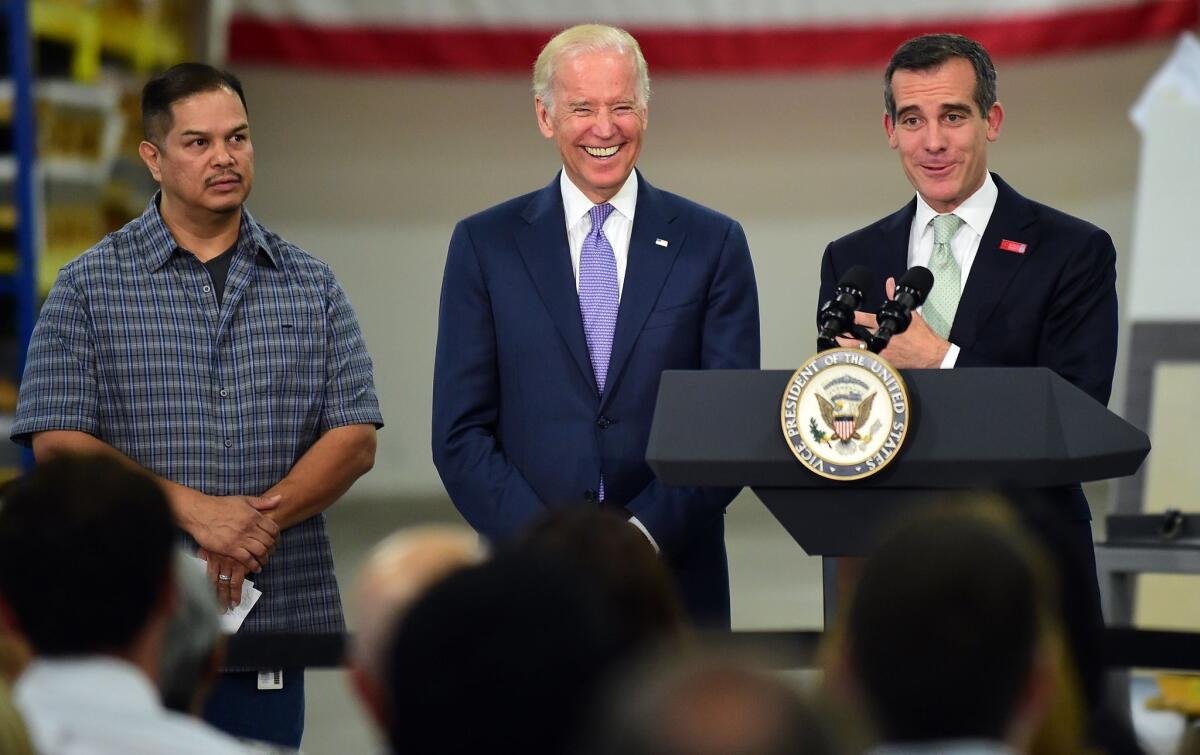Editorial: Let’s mend California’s patchwork of pay scales and wage rules

Vice President Joe Biden laughs as Mayor Eric Garcetti speaks to workers--including longtime employee Rigo Hernandez (left)--at Bobrick Washroom Equipment in Los Angeles in July. Biden came to discuss increasing the minimum wage.
- Share via
As more cities adopt higher minimum wages, California is becoming a confusing patchwork of pay scales and wage regulations. This poses multiple challenges for businesses: compliance headaches for those whose territories cross municipal boundaries, competitive challenges for those in higher-wage cities and employee retention problems for those in lower-wage ones.
Consider the Bay Area. Minimum wage workers in San Francisco get $12.25 an hour, increasing to $15 in 2018. In Oakland, the minimum is also $12.25, but with annual increases pegged to inflation. In Berkeley, it will be $11 starting next month and $12.53 in October 2016. And in Emeryville, it’s $12.25 for small companies and $14.44 for companies with more than 55 employees. And those are just the wages. The cities also have different rules on sick leave, future wage increases and exemptions for nonprofits and trainees.
San Jose Mayor Sam Liccardo hopes to avoid the competition and confusion that can arise when neighboring cities impose different minimum wages. He’s one of eight Silicon Valley mayors who have backed a study to analyze the impact of setting a common minimum wage across the 15 cites in Santa Clara County. While it won’t be easy to persuade city councils with different constituents and ideologies to adopt the same wage schedule and rules, the Silicon Valley leaders have the right idea. In urban regions, where city boundaries are almost indistinguishable, it’s better for businesses and workers when the wage rules are clear and consistent across jurisdictional lines.
Politicians in Southern California, which face a similar mishmash of minimum wages, should take a cue from their Northern California colleagues and proactively rally cities in the region to develop a cohesive wage policy. Earlier this year, the Los Angeles City Council adopted a plan to raise the wage to $15 by 2020 (2021 for businesses with 25 or fewer employees). The L.A. County Board of Supervisors then passed the same plan for the unincorporated areas. Pasadena, Santa Monica, Malibu and Long Beach are considering their own wage hikes, and West Hollywood’s mayor has said she wants to get to $15 sooner than Los Angeles. But those are just a handful of L.A. County’s 88 cities. What about Glendale, Inglewood, Torrance and other cities neighboring L.A. and the unincorporated communities?
As the mayor of the county’s biggest city, which passed SoCal’s first local pay hike, Eric Garcetti should be leading a broad public effort to create a regional minimum wage. He made an initial appeal last year for SoCal cities to raise their wages, but it’s going to take strong political leadership to build the consensus needed to ensure that thoughtful minimum wage laws blanket the region, instead of patchy wage policies that hurt businesses and workers.
Follow the Opinion section on Twitter @latimesopinion and Facebook
More to Read
A cure for the common opinion
Get thought-provoking perspectives with our weekly newsletter.
You may occasionally receive promotional content from the Los Angeles Times.









